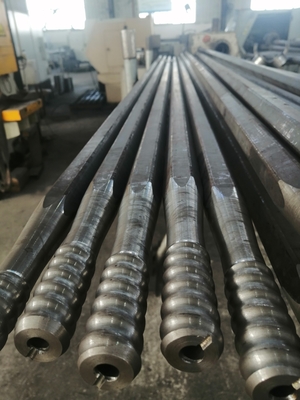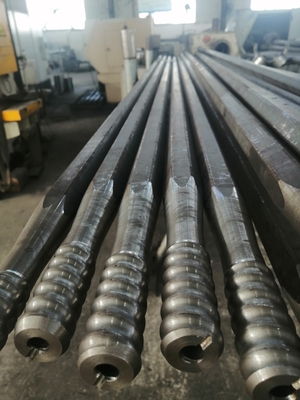Hexagonal - Type Thread Drill Rod Bundle Package With Customized Option
Product Description:
The extension rod, also known as Extension drill steel, Extension drill rod, and Extension steel, M/F rod (Speedrod) produces either a Hexagonal or round cross section. Hexagonal rods are more rigid, heavier, and transfer energy more effectively as they increase flushing. Round rods, on the other hand, are generally lighter and are typically suitable for extension drilling applications.
Conventional extension steel features a duplicate thread on each end, and is usually larger in diameter and longer in length. Whatever your application, these rods provide formidable strength while ensuring integrity and durability.
Features:
Extension Rod and M/F Steel Process
The extension rod and M/F steel process often employs the carburization of heat treatment to increase strength and enhance performance and reliability of highly-powered and fast-spinning drill string components.
Carburization is a hardening technique whereby carbon is injected into the internal and external surface of the rod to increase its hardness and prolong its useful life. The resultant hard surface layer is a robust, long-lasting and durable defense against high external loads and abrasive conditions without weakening the effect of the steel.
Technical Parameters:
We offer a variety of thread types, which include R22, R25, R28, R32, R38,T38,T45,T51. Our drill diameters come in Hex 25, Hex 28, Hex 32, Hex 35, RD 39, RD 46, RD 52, and we offer both round and hexagonal rod types. We use high strength alloy steel imported from top level steel manufacturer to ensure the best quality of our products. In addition, we use CNC milling and proprietary heat treatment processes to ensure further durability. We also guarantee that all of our products are in accordance with ISO9001 certification standards. Lastly, we do not require a MOQ for testing and trail orders.
Applications:
Underground mining is a complex and challenging process that involves excavating minerals and ore from the deepest underground layers. This is typically accomplished by drilling and blasting or tunneling and drifting through subsurface rock in order to access the desired material.
Drifting and tunneling are two commonly underground mining techniques used to access higher grade ore. Drifting involves the use of long crosscuts made in the walls of a mine, while tunneling involves constructing galleries through walls and around obstacles. Both techniques rely heavily on proper equipment and careful planning to be successful.
Benching and long hole drilling are additional techniqes uses in underground mining and involve the use of large cavity excavations created using explosives. Benching involves the creation of a series of steps, or benches, at the bottom of the cavity, whereas long hole drilling requires the use of mechanized drill rigs to excavate deeper levels.
Finally, quarrying and open pit mining are two more techniques used for subsurface mining. Quarrying includes the removal of large volumes of material, which is often accomplished using large-scale drilling, blasting, and excavating machines. Open pit mining, on the other hand, is the process of excavating minerals or ore from a surface layer using a large pit.
Support and Services:
We provide technical support and service for Thread Drill Rod.
Our technical support and service includes:
- Product installation and maintenance guidance
- Troubleshooting and repair
- Assistance with product selection
- Product training
- Product performance and optimization
We are committed to providing our customers with the best possible service and support. If you have any questions, please contact us.
FAQ:
Q&A about Thread Drill Rod
- Q: What's the Brand Name of Thread Drill Rod?
A: The Brand Name of Thread Drill Rod is MTH.
- Q: Where is Thread Drill Rod made?
A: Thread Drill Rod is made in CHINA.
- Q: What kind of certification does Thread Drill Rod have?
A: Thread Drill Rod has ISO9001 certification.
- Q: How will Thread Drill Rod be packaged?
A: Thread Drill Rod will be packaged in wooden case or bundle.
- Q: What kind of payment terms are accepted for Thread Drill Rod?
A: Thread Drill Rod can be paid for by T/T, Western Union.




 Your message must be between 20-3,000 characters!
Your message must be between 20-3,000 characters! Please check your E-mail!
Please check your E-mail!  Your message must be between 20-3,000 characters!
Your message must be between 20-3,000 characters! Please check your E-mail!
Please check your E-mail! 


